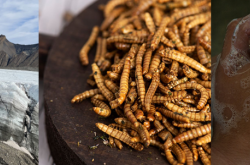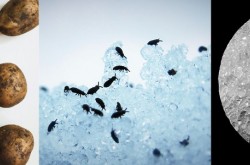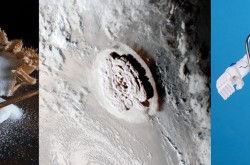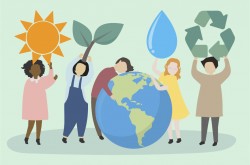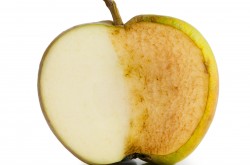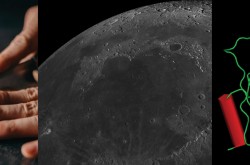3 Things you should know about new energy technologies, human-influenced mineral formation, and the versatile uses of mushrooms

Meet Michelle Campbell Mekarski, Renée-Claude Goulet, and Gordon Bardell.
Michelle and Renée-Claude are two of Ingenium’s science advisors, providing expert scientific advice on key subjects relating to the Canada Science and Technology Museum and the Canada Agriculture and Food Museum, respectively. Guest contributor Gordon Bardell is a science communications intern at the Canada Science and Technology Museum and the Canada Aviation and Space Museum. He is filling in this month for Cassandra Marion, science advisor at the Canada Aviation and Space Museum.
In this colourful monthly blog series, Ingenium’s science advisors and guest writers offer up quirky nuggets related to their areas of expertise. For this August edition, they tell us how new technologies are expanding our sources of energy, how human activity has created conditions for new minerals to form, and how mushrooms have the potential to lead us to a healthier, more sustainable future.
“Alternative” alternative energy sources
Energy is a wickedly complex problem. We need it to power our homes, transport us, create our clothes, grow our food, and a million other things. To be useful, energy must be affordable and reliable – it isn’t much good if no one can afford it and it’s constantly turning on and off. But energy isn’t free – it has costs to us and to our planet. Fossil fuels are limited and affect air quality and climate. Nuclear power has waste management challenges. Hydropower disrupts local ecosystems. Even renewable energy like solar and wind require limited materials and extensive mining. Hundreds of millions of people worldwide lack access to power, and the global population continues only to grow. There’s also the logistical challenge of delivering energy, handling high demand (like during heat waves), and building an energy system resilient to disruptions and disasters.
It’s no wonder that engineers and scientists are constantly exploring innovative solutions that can meet these challenges. And they have come up with some pretty creative solutions! Here are three “alternative” alternative energy sources that you might not have heard of.

Dance clubs in London and Rotterdam “dance to save the world” by using energy from dancers to power sound and lighting in their clubs.
Have you ever felt the energy when a great song comes on and people rush to the dance floor to boogie their hearts out? A couple of nightclubs are using that dance-energy to generate electricity! The dance floors are made of piezoelectric materials. If you compress these materials, the molecules stretch or squeeze in a way that moves positive and negative charges, which creates electricity. So, by simply walking and bouncing on the floor, the dancers were creating useable power!
What if we could use all of the wasted body heat that humans generate just by being alive? In Stockholm Central Train Station, the heat from 250,000 daily passengers is captured by the ventilation system and used to heat water. The water is then piped into nearby buildings to help heat them, cutting their heating bills by up to 25 percent.
One challenge of new power sources is that many would require expensive new infrastructure to use. Our last alternative energy source makes use of widespread existing infrastructure. It’s Wi-Fi! Wi-Fi uses radio waves to transmit information, and since radio waves are a form of electromagnetic radiation, they carry energy. Special antennas called rectennas can take energy from radio waves (including Wi-Fi) out of the air and convert it to electricity. There is very little energy in radio waves, so this technology wouldn’t be able to power a cell phone yet, but it has promising applications for passively charging low power medical devices (think implants) and sensors.
Innovative energy solutions like dance floors, body heat, and Wi-Fi waves showcase the potential of creative thinking in addressing our global energy challenges. As technology advances, these alternative sources could play a vital role in building a sustainable and resilient energy future.
By Michelle Campbell Mekarski
Anthropogenic Alchemy: How Humans Cause the Formation of New Minerals
In 1959, a geologist named René Van Tassel found something strange growing in the oak cabinets of the Royal Museum of Natural Science of Belgium in Brussels. It wasn’t mould or insects, it was a new mineral growing on the surface of some museum samples.
A mineral is a naturally occurring crystal-like substance that does not come from plants or animals and follows a repeating pattern of the same elemental building blocks. This new substance found by Van Tassel, defined as a whitish mineral that grew in a hairlike or a flowery pattern across the surface of minerals, fossils, or ceramic artifacts, had never before been seen in nature. He named it calclacite. As it turns out, this mineral grew because of the oak cabinets the artifacts were stored in.
Oak wood is very acidic and tends to release acetic acid, the same acid that gives vinegar its distinct smell and taste. This acid reacted with the calcium in the samples, creating a new mineral that grew on their surfaces. This mineral belongs to a group of minerals that only exist on Earth due to human influence.
These minerals were always theoretically possible but had not been found on Earth in the past because the ingredients to make them had never been in the same place at the same time. However, humans like to pick things up and move them around. Mining and the transportation of materials mean these ingredients are moved to new places and put with other ingredients needed for making minerals. This group of newly discovered minerals, which needed a bit of human help to grow, are known as anthropogenic minerals. The word anthropogenic comes from the Greek words “anthro,” meaning human, and “pogenic,” meaning causing. However, to be considered a mineral, a substance needs to be naturally occurring. So, geologists consider anthropogenic minerals “human-influenced,” rather than “human-created.”

Abhurite is an unusual new mineral found growing on tin found in sunken ships. It is one of 208 new mineral species found in 2017 created by human interactions with the Earth.
Another interesting anthropogenic mineral was discovered on tin found in sunken ships. Mined tin was refined, cast into ingots and tools, and sent around the world on ships. When those ships sank, they introduced tin in high concentrations to chemicals found in large bodies of water. This allowed for a new mineral called abhurite to form as a mix between the tin and oxygen, water, and chlorine from the salt water. Once again, humans influenced the formation of this mineral by introducing ships full of tin to the ocean depths. Once the tin was there, nature took over and created a new mineral.
Anthropogenic minerals show that the human influence on the planet is more profound than we might think. Our actions have caused not only changes in climate and in species’ patterns (such as migration patterns, the endangerment of species, and the introduction of invasive species), they have also influenced mineral formation on the planet.
By Gordon Bardell
Celebrating the mighty mushroom; a boon for sustainability
Love them or hate them, mushrooms are a strange and fascinating food. Surprisingly, up until as recently as the 1960s, mushrooms were considered a form of plant. But advances in biological research highlighted fundamental differences between them and other life forms, particularly plants and animals. So mushrooms got their very own category — fungi — by the late 60s.
Have you ever stopped to think about what mushrooms are made of? They're not plants, and they're not animals, so what exactly are they? The fact they are so unique in their biology makes them extremely versatile, offering uses as food, in medicine, and in manufacturing. In fact, many researchers are working to understand them better, seeing their potential to lead us to a healthier more sustainable future.

Mushrooms are nature's oddballs, neither plant nor animal, thriving underground and surprising us with their versatility.
The mushrooms we cook and their toxic relatives represent just a tiny fraction of the vast diversity of fungi. In fact, thanks to advances in genomic technology, some scientists estimate there may be as many as 5.1 million different species in the fungi kingdom! Some are helpful; yeast fungi contribute to the production of bread and alcohol, while moulds are responsible for the distinct flavours of stinky cheeses. Other fungi, such as rusts and smuts, can devastate crops, and others may even infect our bodies and make us sick.
Mushrooms we eat are the fruiting bodies of specific fungi, much like flowers are to plants. This explains why mushrooms appear, develop, shed their spores, and decompose so quickly. The main part of the mushroom organism is actually hidden the majority of the time, underground or within its food source. It forms a network of thin, thread-like fibers called hyphae, which create a glue-like substance as they grow. When it's time to reproduce, the fruiting bodies appear; they are made of the same material as the hyphae, just tightly packed together and known as mycelium.
Unlike plants, whose cell walls are made of cellulose, mushrooms have cell walls composed in part of chitin. This structural molecule is also found in the exoskeletons of insects, the shells of crustaceans and mollusks, and certain seaweeds. The chitin is what makes mushrooms rubbery and nearly impossible to overcook. Chitin doesn’t break apart with heat like cellulose does, which is what makes vegetables or fruits go mushy if overcooked.
As distinct from plants, mushrooms can't produce their own sugars through photosynthesis. Instead, they consume other organisms for survival and reproduction, digesting food externally before absorbing it. As decomposers, mushrooms play a crucial role in recycling nutrients from dead organic matter back into the ecosystem. This means they can play an important role in creating a circular economy in agriculture, where wastes are re-used and treated as a resource.
Additionally, mushrooms are being explored for innovative uses, such as mushroom-based leather, building materials, and packaging. They are effective at cleaning up pollutants, often outperforming bacteria, although they take longer. Because of their interesting nutritional and physical properties, they are also increasingly used in the production of fake meat. However, cultivating mushrooms is a slow, energy-intensive process requiring specific conditions, so many researchers are looking to biotechnology to improve mushrooms' efficiency and suitability for these applications.
Research in wound-dressing technology is also exploring how mushrooms can be used to improve healing. As mentioned, chitin is found in mushrooms. Chitin that is derived from crustaceans is already used for medical healing, and chitin from mushrooms was found to have the same healing properties. Fungi could therefore be a sustainable alternative source of this useful molecule for the medical industry.
With their culinary versatility, nutritional value, and potential in various industries, mushrooms are indeed a remarkable and multifaceted organism. They offer numerous health benefits due to their bioactive compounds and could even lead to new medicines and health products to keep our brains and bodies healthy into old age. Whether in the kitchen or in the lab, mushrooms continue to surprise and impress with their wide-ranging proven and potential uses!
By: Renée-Claude Goulet
Enjoying the Ingenium Channel? Help us improve your experience with a short survey!

















